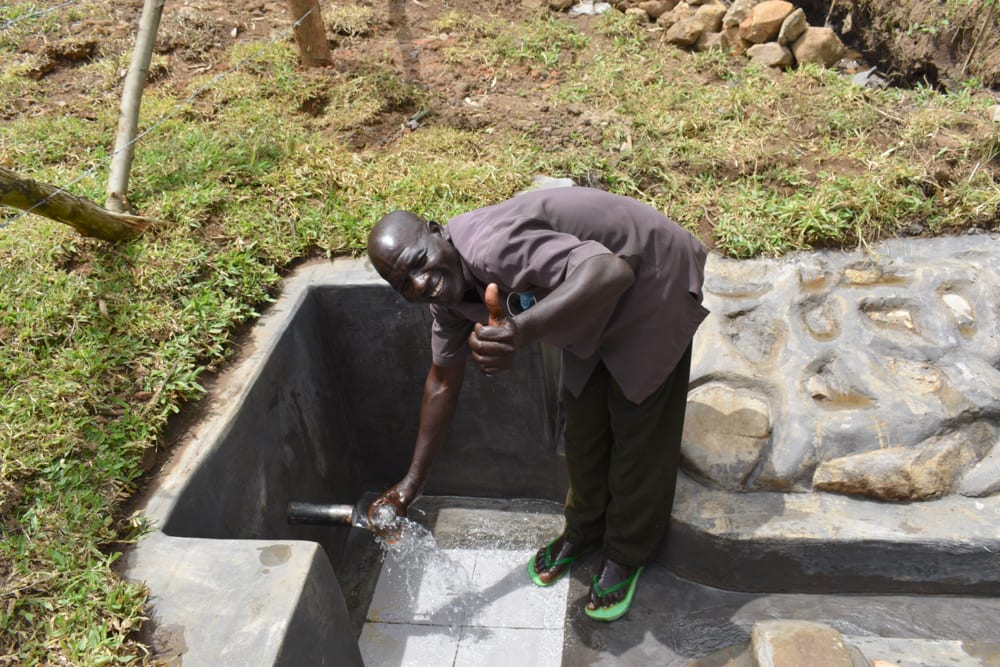April, 2021: Zebedayo Mutsotsi Spring Project Complete!
Mukoko Community now has access to clean water! We transformed Zebedayo Mutsotsi Spring into a flowing source of water, thanks to your donation. Our team protected the spring and trained the community on improved sanitation and hygiene practices, including COVID-19 prevention.

Zebedayo Mutsotsi and his wife say cheers over a glass of clean water from the protected spring named for their family.
"Accessing clean and safe water is the best thing that has ever happened in my life. I am optimistic my health and that of my family will be greatly improved. The many resources we have been using to cater to medications after contracting water-related diseases will be used to cater to my family, leading to better health standards. The protection of this spring will enable me to save on much time taken to fetch water and embark on understanding other development activities," said Okang'a Smith, a farmer in the community.

Okang'a Smith fetches water at the spring.
Children were just as excited as the adults about the new water point.
"I am so happy. I will now be able to access water from this water point so easily and conveniently. I will now be able to save time whenever I go for water at the spring. That time will now be used to study more," said a young Nelly.

Nelly takes a gulp from her glass of clean spring water.
Preparing for Spring Protection
Community members worked together to source and carried all locally available construction materials to the spring. These included bricks, sand, stones, and fencing poles. Some people also chiseled away at large stones to break them down into the gravel. Because people have to carry most items by hand, the materials collection process can take anywhere from a few weeks to months.

Children help deliver bricks to the spring site.
When everything was prepared, we sent a lorry to the community to deliver the rest of the construction materials, including the cement, plastic tarps, and hardware. Then, our artisan and field officers deployed to the spring to begin work. Individual households provided meals throughout each day to sustain the work team.
From Open Source to Protected Spring: A Step-by-Step Process
At last, it was time to dig in at the spring! Women and men lent their strength to the artisan each day to help with the manual labor. First, we cleared and excavated the spring area. We dug a drainage channel below the spring and several surface runoff diversion channels above and around the spring. These help to divert environmental contaminants carried by the rains away from the spring.

Excavation
To ensure community members could still fetch water throughout the construction process, we also dug temporary diversion channels from the spring’s eye around the construction site. This allowed water to flow without severely disrupting community members’ water needs or the construction work.

Laying the foundation
Excavation created space for setting the spring’s foundation made of thick plastic tarp, wire mesh, concrete, and waterproof cement. After setting the base, we started brickwork to build the headwall, wing walls, and stairs.

Bricklaying begins
Next, we began one of the most crucial spring protection steps to ensure a fully functional water point: setting the discharge pipe. The discharge pipe has to be low enough in the headwall so that the water level inside never rises above the spring’s eye, yet high enough to leave eighteen to twenty inches between the pipe and the spring floor. This allows room for the average jerrycan (a 20-liter container) to sit beneath the pipe without making contact.

Setting the pipe
If the discharge pipe were placed too high above the spring’s eye, too much backpressure could force the flow to emerge elsewhere. Too low, and community members would not be able to access the water easily. We embedded the pipe using clay (or mortar when the clay is in short supply) and placed it at a slight incline to ensure water flows in the right direction.

Stone pitching
In coordination with brickwork, we pitched medium to large stones on both sides of the spring’s drainage channel. We then cemented and plastered each stone group into place, forming the rub walls. These help to discourage people and animals from trying to stand on that area, which could cause soil erosion and thus a clogged drainage area.

Plastering
With brickwork and stone pitching completed, we turned to cementing and plastering both sides of the headwall and wing walls. These finishing layers reinforce the brickwork and prevent water in the reservoir from seeping through the walls. In turn, enough pressure builds in the reservoir box to push water out through the discharge pipe.

Setting the tiles
As the headwall and wing walls were curing, we cemented and plastered the stairs and installed four tiles beneath the discharge pipe. The tiles protect the concrete from the falling water’s erosive force while beautifying the spring and facilitating easy cleaning of the spring floor.

Backfilling with clay
We transitioned to the final stages of construction with the tiles in place - backfilling the reservoir box. First, we cleared the collection box of any debris that may have fallen in since its construction, such as dead leaves or other items. Then we redirected the temporary diversion channels back into the reservoir box, channeling water into this area for the first time. We closed off all of the other exits to start forcing the water through the discharge pipe only.

Backfilling with stones
With much help from the community, we filled up the reservoir area with the clean and large stones they gathered, arranging them in layers like a well-fitting puzzle. We covered the stones with a thick plastic tarp to minimize potential contamination sources from aboveground, followed by a layer of soil. We piled enough soil on top to create a slight mound to compensate for the backfill’s future settlement.

Zebedayo Mutsotsi plants grass at the spring.
Community members transplanted grass onto the backfilled soil to help prevent erosion. Finally, the collection area was fenced to discourage any person or animal from walking on it since compaction can lead to disturbances in the backfill layers and potentially compromise water quality.

Fencing
The entire construction process took about two weeks of work and patience to allow the cement and plaster to finish curing. Members of this community were anxious and eager to fetch water from the protected spring right from the onset. Once the construction was complete and the spring declared usable, members of the Mukoko community started fetching water immediately. Happiness, thanksgiving, and appreciation were the order of the day flowing in all directions.

Josephine Ondeyo fetches water from the completed spring.
Training on Health, Hygiene, COVID-19, and More
Due to the ongoing challenges and restrictions amidst the pandemic, we worked with local leaders and the national Ministry of Health to gain approval for a small group training about health, hygiene, and COVID-19 prevention.
Together with the community, we found their preferred date for training while considering other community calendar events, such as the agricultural season and social events. We requested a representative group of community members to attend training, who will relay the information learned to the rest of their family and friends.

Trainer Jacky shows how to build a tippy tap handwashing station.
When the day arrived facilitator Jacklyne Chelagat deployed to the site to lead the event. 21 people attended the training, including the local Village Health Volunteer. We held the training outside at the spring site under trees. The shade coupled with the fresh air made the entire training conducive.

Fred practices handwashing next to Trainer Jacky.
Perhaps the most crucial topic of the day was our session on COVID-19 prevention and control. Due to the rampant spread of misinformation about COVID-19, we dedicated time to a question and answer session to help debunk rumors about the virus and provide extra information where needed. We also left behind a rice sack painted with messages of COVID-19 prevention reminders in the local language. We affixed the sign to the spring's fence during training and encouraged community members to use it as a daily reminder to stay cautious both at home and at the spring.

Mask-making session
We covered several other topics, including community participation in the project; leadership and governance; personal and environmental hygiene; water handling and treatment; operation and maintenance of the spring; dental hygiene; the ten steps of handwashing, and how to make and use a tippy tap and leaky tin. The session on spring maintenance was particularly memorable because the spring's landowner and namesake, 84-year-old Zebedayo Mutsotsi, said that if anyone was found vandalizing the protected spring, he would personally take charge of punishing them swiftly to ensure the spring's longevity.

Trainer Jacky stands next to the elected leaders of the water user committee.
We held an election for the newly formed water user committee leaders during the leadership and governance session. We also brainstormed income-generating activities that can be used to start a community savings account for any future minor repairs to the spring and a cooperative lending group to enable members to develop small businesses.

Albert Mutsotsi gives thumbs up at the spring.
"This training has equipped us with adequate knowledge and information that will go a long way in improving our sanitation and hygiene standards, which will translate to better health care and key information on how to maintain and preserve our new protected water source," said Albert Mutsotsi, a local business owner and the elected Chair of the water user committee.

Zebedayo Mutsotsi practices the ten steps of handwashing at training.
"Education is power. I am totally a different person having acquired the most important information, I am knowledgeable and sure that my life is going to change once I implement all I have learned," said Zebedayo Mutsotsi.
"The demonstration on making a homemade mask was so important. Most times we are forced to wash the surgical masks and wear them again. Being old, I am still worried about the virus, but at the same time, I am very keen on following the well-laid regulations," Zebedayo added.

Zebedayo celebrates the completed spring.
When an issue arises concerning the water project, the water user committee is equipped with the necessary skills to rectify the problem and ensure the water point works appropriately. However, if the issue is beyond their capabilities, they can contact our field officers to assist them. Also, we will continue to offer them unmatchable support as a part of our ongoing monitoring and maintenance program.

Kids pose at the spring.
Thank you for making all of this possible!


 Protected Spring
Protected Spring
 Rehabilitation Project
Rehabilitation Project













































